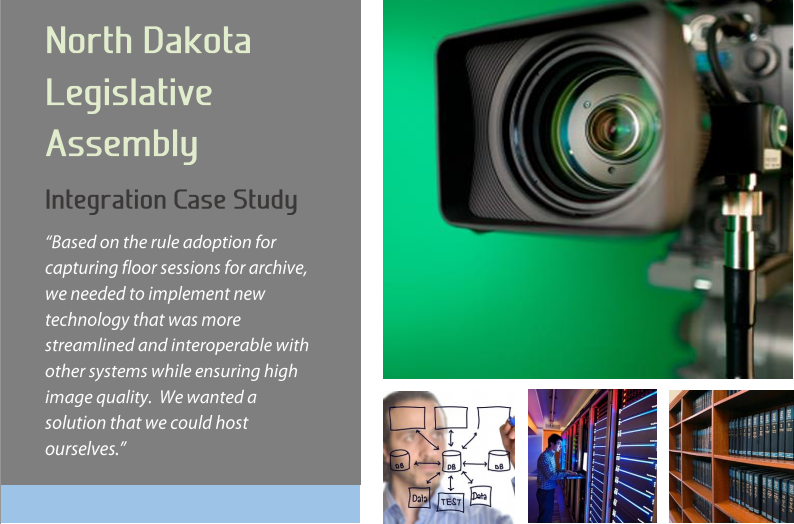The North Dakota Legislative Assembly meets biannually to create, amend and repeal state laws. An internal team of IT professionals and recording clerks has handled the live streaming of legislative chamber floor sessions, viewable online at www.lea is.nd.aov. Chamber video was not recorded nor archived for later playback.
The Legislative Assembly adopted a rule to record and archive legislative chamber floor sessions starting with the 2013 regular session — a rule that wasn‘t being fulfilled in the current workflow.
“We were streaming content live from camcorders,” said Kyle Forster, information technology manager for the Legislative Branch. “Based on the rule adoption for capturing floor sessions for archive, we needed to implement new technology that was more streamlined and interoperable with other systems while ensuring high image quality. We wanted a solution that we could host ourselves.”
The SolutionTo increase efficiency across the workflow, NDLA adopted the Sliq Harmony Hub solution consisting of VM-hosted application servers and physical video encoders. NDLA then rapidly integrated their data sources related to daily chamber schedules, bills, members and votes into the Harmony Hub solution using web services and drop folders. International Roll Call Corporation, a third party platform for real-time voting board displays also was asked to provide a data hook to expose real-time XML feeds that hooked seamlessly into the Harmony platform. The complete solution automates the ingestion, presentation and management of streaming content that the Legislative Assembly delivers to desktop and mobile consumer devices. The flexible Sliq architecture also allows NDLA to self-host the solution and leverage its existing architecture. NDLA has the option to transition to Sliq cloud services at a later time should it so desire.
The scalable Harmony architecture incl udes Sliq Razorback encoders for multi-channel video and audio recording with local disk loop recording, and multi- resolution encoding capabilities up to 1080p high definition. The central Sliq Harmony content management system running on NDLA virtual servers is ultimately responsible for indexing, linking and leveraging trapped data from voting, scheduling and other workflow systems. Web-based quality assurance and monitoring interfaces are provided for manual adjustments and business continuity purposes.
“Harmony essentially manages all of our videos, and delivers redundancy in the event of a recording mistake,”
said Forster. “The technology provides a perpetual video recording buffer, or “ring buffer,” that enables us to simply and rapidly recapture lost video due to accidental stops or scheduling errors. The ring buffer ensures we are safe as long as our cameras are rolling.”
The BenefitsThe Sliq sol ution allows NDLA to fully exploit existing data generated by bill tracking, scheduling and real-time voting systems in an exceptionally simple manner. Elected members, legislative staff, citizens and anyone interested can now simply locate cross references for bills, members, votes, chamber orders of business and other pertinent information, and find all relevant video with ease.
Constituents notice the val ue of automated indexing when they find neatly indexed information pages for every bill handled by the assembly, along with any legislator who requested to speak during a floor session. This incl udes links to documents that were discussed at specific points in the videos.
Additionally, citizens report that they can now easily access live and on-demand meetings from a variety of devices thanks to the streaming arch itecture’s support for multiple formats. Links to and from video and audio, including everything from general meeting agendas down to bill and member references, is delivered with ease — and with exceptional image quality.
The creation of a video archive also means that the NDLA is in compliance with the Legislative Assembly‘s rule adoption. Citizens who miss live floor sessions can visit the website at a later date, and view video with all associated indexed information right beside each video. The depth of the indexed content also means that citizens can drill right down to specific bills of interest.
Technical Details5cheduling and Bill Tracking Dora
The NDLA cham ber management system (LEGGS) automatically reconciles calendar changes, and updating program guides and recording schedules to ensure videos are recorded even if meeting times change by using the Harmony Hub XML drop folder feature. NDLA had direct access to the Harmony API backplane to keep the systems synchronized.
Reol-Time DotoA custom command automatically accepts insertions from International Roll-Call (IRC) voting systems, seamlessly indexing detail into the video for chamber orders of business, bills spoken about and voted on by members. Furthermore, the Sliq architecture offers


